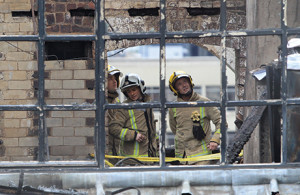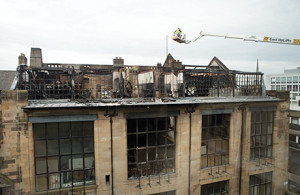As Page/Park Architects are chosen to lead the restoration of the iconic Mackintosh building, Project Scotland’s Ciaran Pasi visits the fire-damaged landmark
WALKING through the Glasgow School of Art, past bare studios filled only with smoke stained panels and charcoaled debris, into silent rooms bathed in light with the original brickwork exposed through hollow blackened walls, it’s startling just how empty, eerie and morose the building feels.
It’s still hauntingly beautiful, and to some degree the fire has further revealed the extent of Charles Rennie Mackintosh’s architectural genius. Rooms that were once partitioned off into individual cubicles can now be seen as they were intended in their full open splendor. Minute hatched windows, previously boarded over and hidden from view have been revealed for the first time in decades, with shards of light breaking through their panes again.
But charred and desolate, without the students that make the art school and bring it to life, the building feels sombre and flat.
The Glasgow School of Art is rightly revered as an architectural masterpiece and it is internationally cherished by the public and past alumni alike. Yet it is not a relic or museum, the building is designed to be a functioning art school and it is perhaps so loved because of how well it functions.
“That is the wonder of the art school,” said Liz Davidson, Senior Project Manager of the Mackintosh Restoration Project.
“That it is this amazing, world-class, iconic A-listed building but it’s just being used regularly, with over 2000 students moving through it and not worrying about that status.”
Last May the fire that tore through the building destroyed the renowned art nouveau Mackintosh library, damaged stairwells and studios, the famous ‘hen run’ and roof and took with it the work of many final year students preparing for their upcoming degree show.
In scenes that followed there was public outpourings of grief and personal stories of bygone times in the school from former students such as Muriel Grey and Peter Capaldi. The aftermath seemed more like the wake of a lost loved one than the reaction to a burnt building, with esteemed patrons and everyday punters recounting anecdotes and past experiences that demonstrated just how much the art school means to the people who know it and the city to which it belongs.
“Nothing affected me as much in terms of building loss than what we heard coming through on the 23rd of May,” added Liz.
“I know folk who were art school graduates that stopped what they were doing when they heard and came down and people were hugging and crying in the street watching it. There’s just not many buildings that could do that to people.
“I think it’s because it’s actually been a public building. A lot of folk out there had actually been in or through the Mack’ and even if they weren’t from Glasgow they’ve stayed in Glasgow.”
Firefighters managed to save 90% of the building and 70% of its contents and now Glasgow based practice Page/Park Architects have been appointed to lead the restoration. Having previously worked on Mackintosh buildings including The Lighthouse and Hill House as well as leading the Mackintosh Conservation and Access Project from 2007-09, Page/Park were commissioned from a shortlist of five firms following an extensive interview process.
“What really pipped it for Page/Park was that they developed an approach that was called ‘Building by buiding, room by room, piece by piece.”
“They looked at the spirit of the building and what it represents with regards to Mackintosh on a very macro level and then they looked at rooms and then pieces specifically. They looked at the range of material right down to the minutest detail. I suppose what we had confidence in with the design team is that they really understood what made the building tick. They deconstructed a bay of the library and really there were things that we could never have known if it wasn’t for the fire because it revealed areas of the building we would never have seen otherwise. There was a kind of artifice about it that meant you read pieces as something but in fact it was made up of completely different components. It was very cleverly done using quite simple forms of construction.”
Born in Glasgow in 1868, Charles Rennie Mackintosh trained as an architect with a local practice while studying art and design during evening classes at the Glasgow School of Art. Now renowned as the father of the ‘Glasgow style’, his work was largely unappreciated in his hometown at the time of its construction. Mackintosh’s architectural career was relatively short considering the impact his work has since had on the world of design, with his major architectural commissions designed between 1896 and 1906. Famed for a modernist style that evolved through his art, with a particular focus on natural symbols, geometric patterns and flowing lines, Mackintosh became disillusioned with architecture later in life and devoted his remaining years to watercolour painting.
The Mackintosh building was completed in 1909 and whilst Mackintosh’s entire career is regarded with great esteem, the Glasgow School of Art building is often held as his definitive masterpiece.
“Mackintosh didn’t have a massive output but everything he did was utterly solidly convincing in what he believed. He didn’t compromise in how he plied his trade,” said Liz. “They’re all masterpieces but that one is the masterpiece. But I think mainly it’s because thousands and thousands of young people have passed through that building and have an affection for it.”
Although Page/Park’s work is first and foremost a restoration, amid the devastation of the fire there is now the chance to upgrade previously neglected aspects of the building and thread new technology through the school.
Many of the studios’ roofs, which were designed as pure uncluttered spaces, have been lost over the years beneath external radiators, temporary electrical fixes, detector systems and wiring. The practice now has the opportunity to internalise these additions behind the linings and return other key areas to their original design.
“We did put a big emphasis on the fact is has to be a company that can do absolutely the best conservation you’ve ever seen. But the school as a client also said we want this building to function for the next 100 years. We won’t get this chance again.
“I think services is a really critical part of the job. Although we focus on the architect, the service engineers all had to prove at the interview that the work would be utterly state-of-the-art.
“Yet I think the bottom line is that the school is going to be restored, if we’re going to be simplistic about it. Muriel Grey, Chair of the Board of Governors, stood outside on the day after the fire and said ‘we will rebuild it and we will rebuild well’. It was a gut reaction at the time, probably through tears as the fire brigade were still pumping water onto the cinders, but I think it summed up what Glasgow wanted.”
With restoration work expected to start in Spring 2016, initial design meetings between Page/Park and the Glasgow School of Art are now underway. The project is not only unique in its scope, history and the media attention surrounding the restoration, but also in having the Glasgow School of Art as a client. Although essentially one client, the school is a multi-headed creative establishment with various artistic disciplines that will surely want to contribute to the development.
Some critics of the restoration, some because there have only been a known few, have stressed the need to modernise and change the Mackintosh building’s design. Believing that were Mackintosh alive today, he would push the plans further and use the opportunity for drastic renewal and not meticulous repair. Yet with so many modern developments built with disregard for the traditional environment and the social and architectural context around them, seeing a firm as progressive and acclaimed as Page/Park committing to a faithful restoration, when they could have submitted a proposal to push their name above Mackintosh’s, is refreshing.
After standing in the burnt out Mackintosh library, where wind whispers and whistles through empty window frames and holes in the blackened bricks, it’s hard to envisage designs beyond restoration. Buildings like the Mackintosh are rare architectural gems. Yet while they should be preserved and maintained, they should also be used and enjoyed. The building’s restoration seems more for purpose than for nostalgia or preciousness.
In the coming years the Glasgow School of Art will be restored to a functioning art school, and with streams of students breathing life into its halls once more, hopefully it will inspire future generations of artists who have the chance to discover Mackintosh’s masterpiece again.













